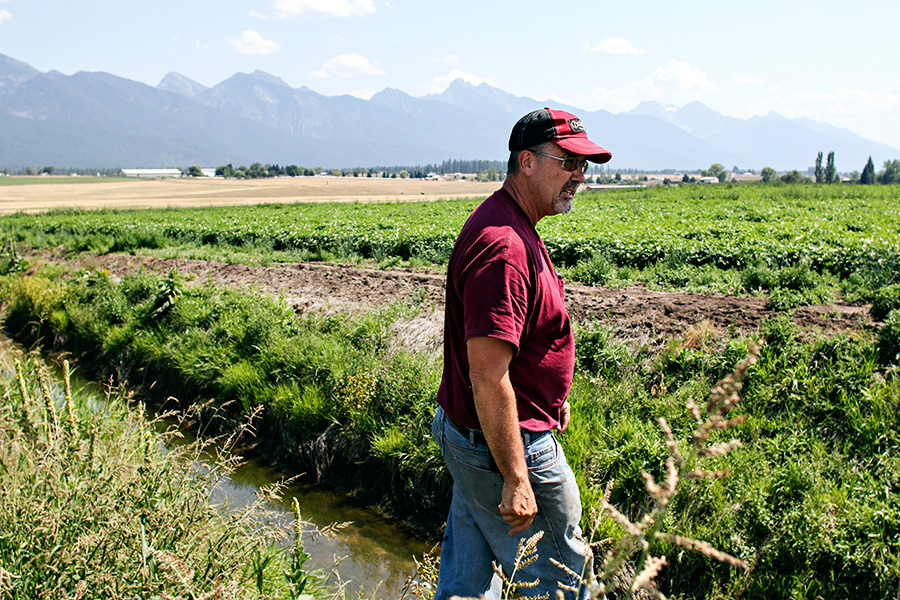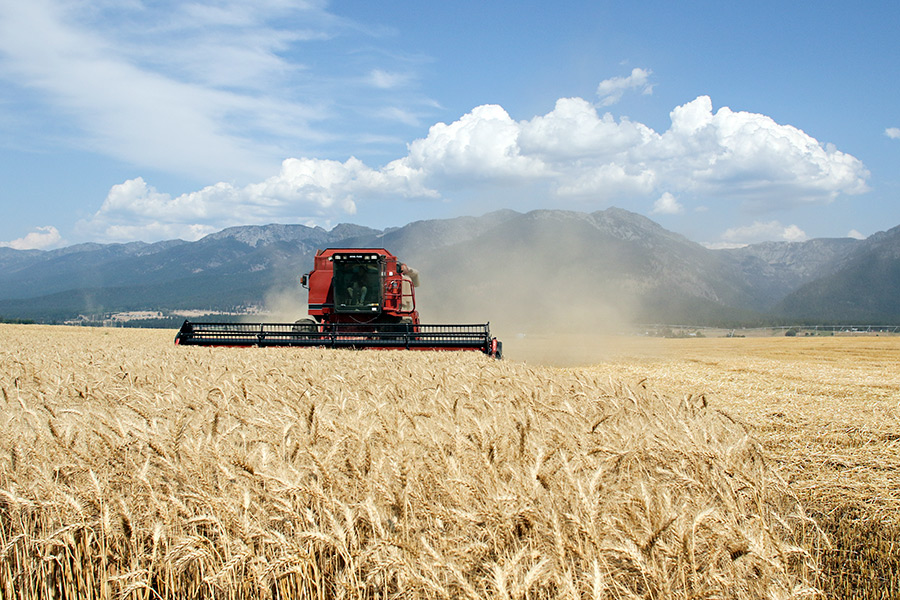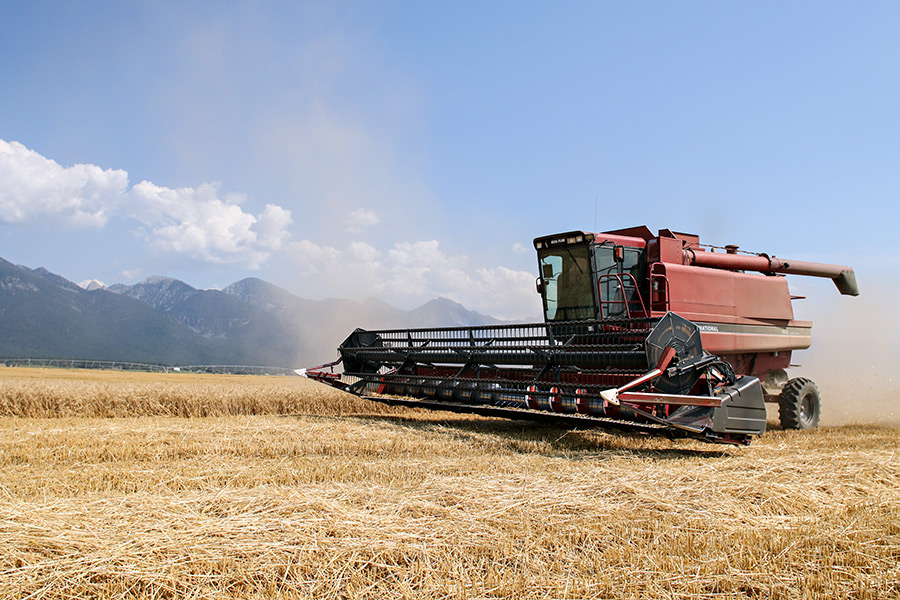RONAN — Smoke and dust shrouded the scenic panorama of the Mission Valley last week as Jack Lake scanned his family’s acreage, one of roughly 2,500 farms and ranches dotting the landscape.
Peering down into the main canal that feeds his property, Lake saw a depleted stream of water, evidence of the severe drought plaguing the region. Roughly 80 percent of his property is dependent on irrigation, a situation that largely extends across the region.
Lake was told most likely, unless a good rainstorm arrives soon, this canal would all but dry up in the coming weeks, over a month early and well before his crops are properly supplied.
Last week the Flathead Irrigation Project announced that each of the various districts in the valley receiving water through irrigated canals are rapidly depleting, if not already dry.
“All water users are cautioned that there may not be water available for stockwater and many ditches will be dry,” the district announced.
Gauging his neighbors’ situations, Lake’s canal seemed in better shape than some, leading him to worry about their chances, along with his own, for this season’s harvest.
“It’s scary,” Lake said. “Basically there’s just not enough water to go around. It’s definitely been a struggle.”
This 1,000-acre plot, bountiful with four varieties of potatoes and an assortment of grains, is where his grandfather Ace Lake moved from Idaho in 1934, searching for a better future for his family in the heat of the Great Depression.
“He was from the end of a ditch,” Jack said. “He got tired of fighting for water, so he decided to pull up and move to Montana.”
Three generations of Lakes were raised on this farm, the latest being Jack and his wife Susan’s four daughters.
But even they were unable to avoid getting swept up in a long-standing fight that has torn at the fabric of the community and is now compounded by a contentious tribal water compact and the sudden emergence of drought conditions.

Water is an everlasting source of conflict and anxiety in the West, but it holds a particular resonance here in the Mission Valley. This countryside is classified as a semi-arid region based on the annual average of 14 inches of precipitation, which is among the lowest in the state and below the national average.
There are over 250,000 acres of agricultural land in the Flathead River basin, and more than 50 percent are irrigated, according to the latest survey by the U.S. Department of Agriculture.
Anyone hoping to make a living off the land here has largely depended on consistent water supplies from the largest irrigation system in Montana, the Flathead Irrigation Project. Built in the early 20th century, the massive project includes 15 reservoirs or dams, over 1,300 miles of canal and lateral systems and over 10,000 minor structures for the diversion and control of water, which is supplied primarily from the Flathead, Jocko and Little Bitterroot rivers and several creeks and streams.
Any system of that magnitude and complexity is sure to garner scrutiny, but the Flathead Irrigation Project has been a particular bone of contention from the outset.
After congressional authorization in 1904, the Bureau of Indian Affairs built the project in the midst of the so-called Allotment Era, when the federal government took lands under the control of tribal governments and allowed individuals to own and sell them. This resulted in the loss of over two-thirds of tribally entrusted lands across the U.S.
The Flathead Reservation saw an influx of white homesteaders who acquired property throughout the region just as the irrigation project was being developed.
Today the debate still rages over who exactly the project was developed for — tribal members living on the Flathead Indian Reservation, or every property owner, including non-tribal members? Who should manage the project? How exactly should it be managed? Who should pay for it and how much?
These questions have circled around the project at the same time the Confederated Salish and Kootenai Tribes have pursued extensive water rights through a compact with the state of Montana and U.S. government. This winter the state Legislature approved the agreement after much debate and Gov. Steve Bullock signed it, sending the proposal to the U.S. Congress for authorization.
The compact, which pitted neighbors against one another and fueled a divisive conflict that raged across the state, includes a delivery entitlement that ensures non-tribal farmers and ranchers continue to receive the amount of water they have historically used, and a provision requiring the tribes to share water during droughts.
However, in the aftermath of the water compact, some feel that the BIA, which runs the Flathead Irrigation Project, is already muddling this agreement through mismanagement.
“There’s no additional water available, and that’s largely due to the drought year. But severe mismanagement of the project and the failure to capture early spring runoff, that’s what is causing irrigation season to end,” said Johanna Clark, executive manager at Flathead Joint Board of Control, a collective representing irrigators that formerly oversaw the irrigation project, and the Flathead Irrigation District, one of the districts that receives water from the project.
Multiple attempts to reach Bud Moran, BIA superintendent of the irrigation project, and Pete Plant, irrigation project manager, for comment were unsuccessful.
Tim Orr, an irrigator and chairman of the FJBC and Mission Irrigation District, echoed Clark’s concerns and claims of mismanagement.
“We can’t argue that this is the worst year in 100 years. But they knew we had no snowpack since February, so that means you start capturing water early. We know the BIA did not practice the drought management plan and didn’t start collecting water until April 15. They wasted a lot of water,” Orr said.
The BIA managed the irrigation project for decades until turning it over in 2010 to a cooperative management entity with equal representation from the CSKT and the FJBC. However, amid the contentious debate over the water compact, the FJBC disbanded in 2013, leading to the BIA retaking control of the irrigation system in early 2014.
Since then the FJBC has regrouped and sued for control of the project again in federal court, leading to the latest conflict that has spilled into public meetings.
In late July, irrigation commissioners for the FJBC denied a request by the BIA to increase assessments for irrigators by $7.50, which would increase per acre irrigation costs to $33.50. The FJBC is tasked with levying fees for irrigators.
The FJBC claimed that the BIA insufficiently explained the need for the increase.
“We asked for full documentation and public hearings to disclose where previous funds were already expended and why this increase is being proposed. That never happened,” Clark said. “The BIA superseded the FJBC. They basically discounted the joint board as the entity that sets the tax assessments.”
The BIA published the proposed rate adjustment in the Federal Register and accepted public comment through Aug. 10.
The FJBC asked the Lake County Commission to step in and endorse the group’s effort, but the commissioners denied the request at a meeting Aug. 10.
Others have said the mismanagement began when FJBC took over control.
Vernon Finley, tribal chairman of the CSKT, said the irrigation project is “in really sad shape” because of improper maintenance that the FJBC should have addressed when it managed the project.
“Proper management would have had all of that taken care of. Instead the farmers and ranchers have basically taken all they can get out of it and it’s now in this state of disrepair,” Finley said.
Finley said the passage of the water compact would benefit the project by addressing the long list of deferred maintenance.
Western Montana has been in the clutches of an historic dry spell with triple-digit temperatures and little rainfall. Kalispell experienced its driest May on record and warmest June. In mid July, Bullock announced that 15 counties across the state, including Flathead, Lake and Sanders, were designated as natural disaster areas due to drought conditions.
For farmers and ranchers, the necessity of the irrigation project has never been more evident.
“This is not about the compact anymore. This is about the survival of the farmers and ranchers residing here on the reservation,” Clark said. “It’s time that all of these agencies put aside whatever political motives they may have and start to work together for the benefit of these people. Here we are on D-Day.”

Lake is optimistic. Being a lifelong farmer, he has learned perseverance. He’s not interested in joining the fight by criticizing anyone. His family has had his fair share already; his father has been a longtime member of the FJBC and Susan Lake remains active in the community conversation over water, speaking regularly at public meetings. Instead, he’d rather everyone sit down and find common ground and solutions.
“I don’t want to get in the mud. There’s no benefit to it,” he said.
“Could the (Flathead Irrigation Project) be managed better, sure it could. But that’s just like saying ‘Have you ever sinned?’ Or “could you have farmed better?’ If you had a crystal ball, you can always do better.”
The Lakes were in a similar situation during the battle over the water compact, and eventually they decided to support it, despite concerns that the water could eventually dry up.
Although he is concerned about the $7.50-per-acre raise and how that will hurt farmers, Lake hopes it would go toward improvements and addressing deferred maintenance that could help the bigger picture in the long run.
At a recent FJBC meeting, Susan Lake expressed similar diplomacy, urging the board and BIA to come together and negotiate outside the courtroom.
“I’m not at all excited about $7.50 (per acre) increase,” Lake said at the board meeting in late July, according to the Valley Journal. “But part of the reason this has happened is because the board chose to go a different direction and sue the BIA rather than work with them … It seems like we have lots of issues and this board should be working to get it back and have a reasonable discussion.”
Somehow, the Lakes have found themselves in the same fight that Ace Lake hoped to escape last century.
“It’s water. Even kids, you listen to their conversations and you know at the dinner table Mom and Dad are having a conversation about water,” Lake said.
“Without water, you just can’t survive.”
